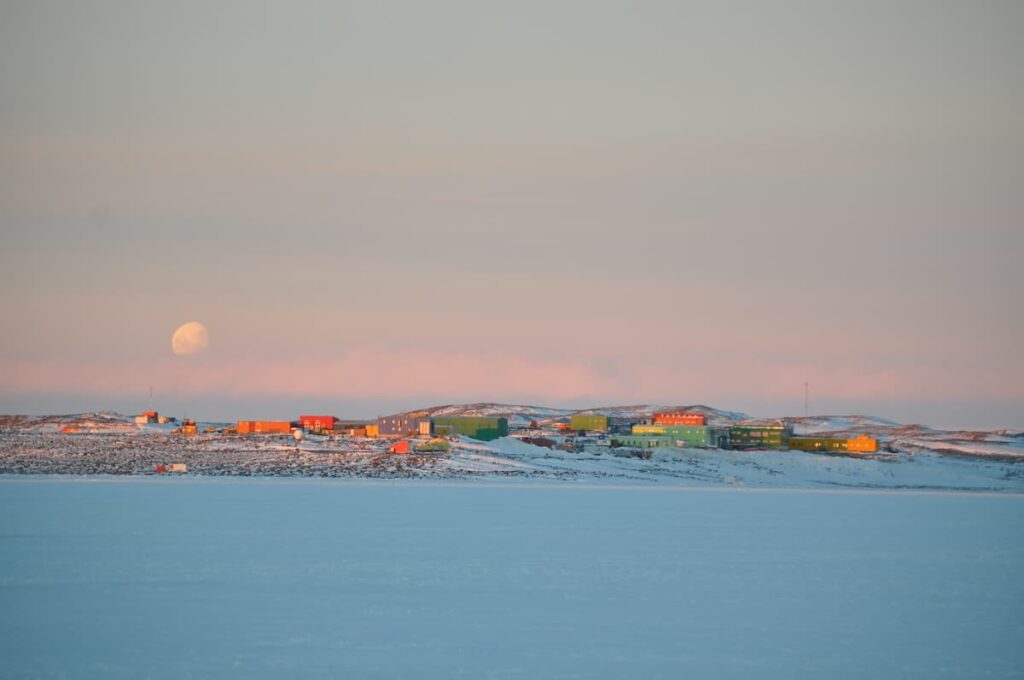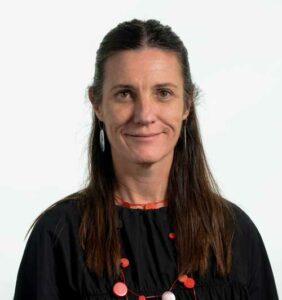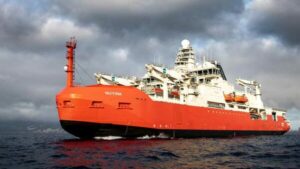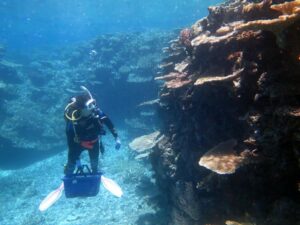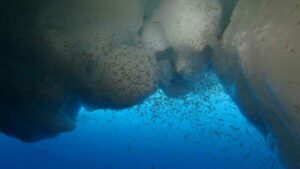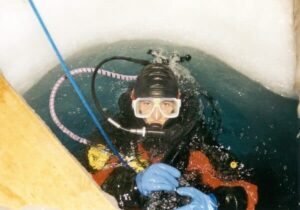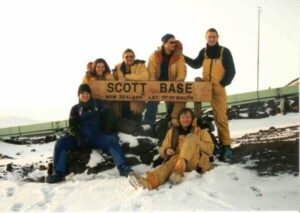This marine scientist, Dr Nicole Webster, switched from coral to ice, thanks to a growing awareness of the role that scientific research can play in tackling the climate and biodiversity crises. So what can studying Antarctica tell us about our future?
Find out what it takes to become the Chief Scientist of the Australian Antarctic Division in this resource for Year 7-10 STEM students learning about careers and Antarctic science.
Word Count: 1466
By training, Dr Nicole Webster is an expert in tropical marine ecosystems. She’s spent much of her career researching coral reefs – but this year, her life took a cool turn when she was appointed the new chief scientist of the Australian Antarctic Division.
“While I’m a really passionate researcher, and I absolutely love the thrill of scientific discovery, I did get this growing sense of urgency that our world is facing some significant challenges at the moment that science can play a central role in developing solutions for,” Webster says.
Where, she wondered, were her skills going to make the biggest difference?
Was it in conducting fundamental research in her area of expertise, trying to understand how microscopic life contributes to the health of marine ecosystems?
“Or was it,” she counters, “about throwing my hat in the ring and taking up a more significant leadership role, to start to shape science that’s needed to inform solutions to some of those big picture challenges?”
As luck would have it, that’s when Webster saw the chief scientist’s job advertised at the Australian Antarctic Division (AAD).
Now she’s stepped into the role, she’s in charge of understanding, managing and conserving this wild and fragile ecosystem – one of the last frontiers of scientific research on Earth.
“It’s remote, and it’s extreme, and it’s fairly inhospitable – but it’s also a place that’s just so breathtakingly beautiful, and it really captures your imagination and stimulates all your senses,” Webster says.
“There’s really no other place like it on Earth.
“It’s also a very unique environment to study science. There are science questions that can only be answered by researchers in Antarctica.”
And Webster needs to be across them all.
“One of the major challenges going forward in Antarctic science is: how do we grow this field?” she explains. “Because there’s so much to be done, but we’re really restricted by the limited number of people that we can get down to the ice to support their research.”
One next-gen way of doing this takes a leaf out of the book of Mars missions: autonomous technology “that can take observations of the atmosphere, the wildlife, the biogeochemical environment in real-time and provide researchers with unprecedented levels of data that they haven’t had access to before”.
Maintaining and expanding Antarctic research is critical, Webster says, because it helps us study our impact on the rest of the world.
For example, one of the AAD’s biggest current projects is the Million Year Ice Core project, in which scientists are trying to drill so far down into the layers of Antarctic ice that they reach back a million years into the past.
“What happens when you’re looking at the ice sheet is that snow falls over time, and it accumulates and gradually gets compressed into ice at depth,” Webster explains. “As it gets compressed into ice, it attracts these tiny bubbles of atmosphere – so by drilling a core that can travel 2.8 kilometres down into the ice sheet, we can actually reconstruct climate one million years into the past.
“We can’t do that sort of science anywhere else.”
Understanding how climate has changed into the past, she says, is exactly the kind of information we need to predict how humans are shaping it into the future.
“The polar regions are probably the fastest-changing environments on Earth – Antarctica essentially acts like a canary in the coal mine.”
East Antarctica, for example, is home to vulnerable ice sheets that, as they melt, will play a major role in sea-level rise. Meanwhile, atmospheric research in Antarctica – such as understanding the clouds present over the Southern Ocean – can inform global climate models and even our understanding of weather patterns in south-east Australia.
“We also work on some of the biological systems like krill,” Webster says. “Krill are the tiny crustaceans, the most abundant crustaceans on Earth, and they’re the basis of the food web. They provide food for things like seals, penguins, fish, squid and seabirds.”
Since so much of the ocean is reliant on them, it’s critical to understand how many of these critters are around, their distribution both spatially and seasonally, how they can be sustainably fished, and how they’re impacted by ocean warming and acidification.
Webster’s job is to plan, manage and synthesise this research, both now and into the future. But she also has a goal to use her communication skills to bring science knowledge “to the people who really needed to hear about it – the public and decision-makers – so that they can make informed decisions based on science”.
But how, exactly, did a tropical marine scientist end up here, leading research on a remote, wild and frozen continent?
“That’s a great question, and I get asked it frequently and I still haven’t really fully understood myself the key decision points that have happened at various points in my career,” Webster admits.
“At school, I was very heavily interested in literature, poetry and law, so I considered a career path in journalism and the legal profession. I’d always been passionate about the ocean, but it wasn’t really until the end of my schooling that I thought seriously about a career in marine science.
“I applied for James Cook University, and that took me up into the tropics, immersed me in a really vibrant community of coral reef researchers, and I never really looked back.”
Webster stayed on at JCU to complete a PhD focusing on how microbes help keep marine ecosystems healthy.
“The kind of questions that I was asking as a PhD researcher in the tropics were actually not that different to what was needed to understand the Antarctic marine ecosystem,” Webster says. “So when I finished my PhD, I wrote a postdoc proposal to work with the New Zealand Antarctic Division.”
She got the job and soon found herself down in Antarctica, diving beneath the ice of the Ross Sea to collect samples and investigate whether microbes could be used as biomarkers for environmental stress in the Antarctic oceans.
“The latitude almost didn’t matter – it was more driven by the science questions of the role of microbes in marine systems,” Webster says.
Little did she know that she’d be back one day.
After her postdoc work, she was a principal research scientist at the Australian Institute of Marine Science for many years, then in 2017 became a research fellow at the University of Queensland’s Australian Centre for Ecogenomics.
But around that time, ideas for change began brewing in Webster’s mind – and it wasn’t long before she came across the job ad for the AAD. The day after seeing it, she went out to the reef to collect samples for coral spawning. What she witnessed made up her mind.
“Just seeing some of the damage to the reef, from climate change and other impacts, reinforced that feeling that it was the right time in my career to actually take that step and really try to take a leadership role,” Webster recounts.
Now, as AAD’s chief scientist, she’s able to ask incredibly big-picture questions.
“How fast is Antarctica responding to climate change? What do changes in the ice sheet mean for sea-level rise? What do they mean for us here in Australia? Answers to those really global issues need really audacious and very integrated science.”
Personally, she says, “the biggest challenge has actually not been the change from marine science to Antarctic science, but going from being at the coalface of your own discovery, to really taking a step back from that and trying to think very strategically about ‘what are the decisions that are needed to be able to shape Antarctica for the future?’
“That’s a very different sort of mindset.”
Part of her job is to not only help scientists across fields work together, but also drive collaboration on an international scale.
Luckily, collaboration is part of the soul of Antarctic researchers.
“It’s part of working in a hostile extreme and very isolated environment – people know that they can’t achieve science in isolation in those kinds of environments,” Webster says.
“I think we have something like 70 permanent research stations in Antarctica now, representing 29 different countries, and these countries are a really wonderful example of coming together and sharing collaboratively around science.”
And with an indefinite tenure as chief scientist of the AAD, Webster has a view that’s both global and extends far into the future.
“I can really have the luxury of thinking long term and trying to make decisions that are going to position us where we need to be in 10 years’ time, or 15 or 20 years’ time, rather than needing to be concerned about making an impact or changing the direction in the immediate term,” she says.
“The ability to make a really big difference here is huge.”
Log in or Sign up for FREE to download a copy of the full teacher resource
